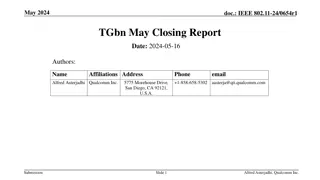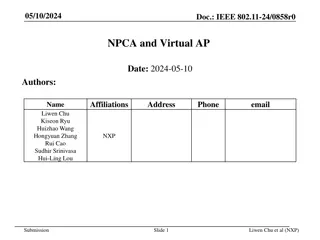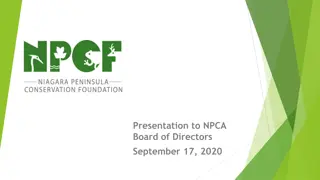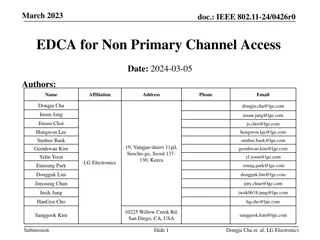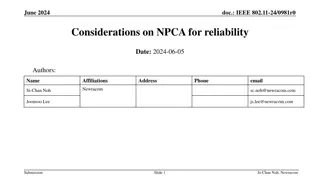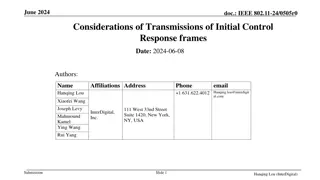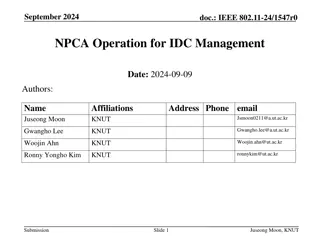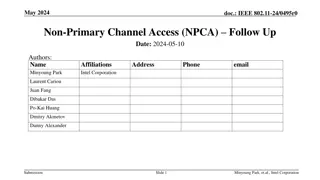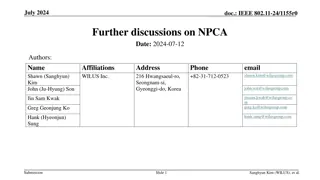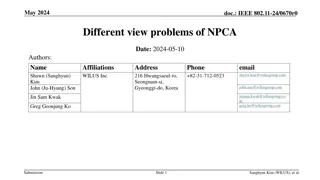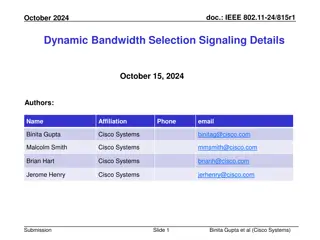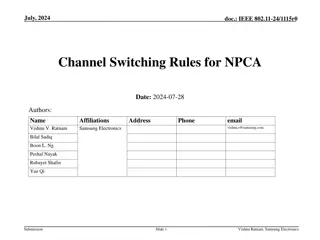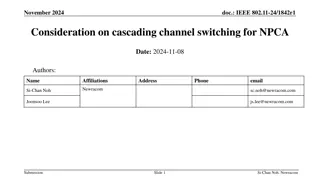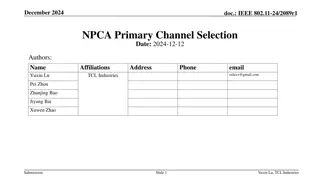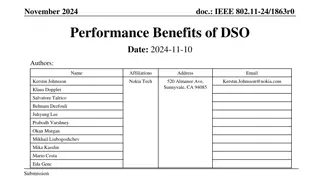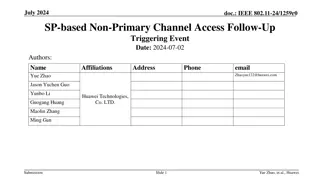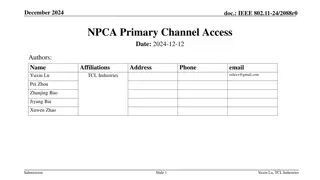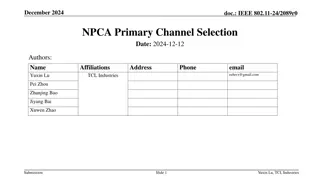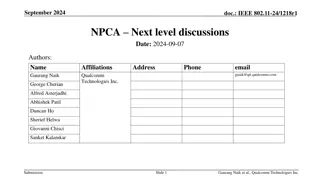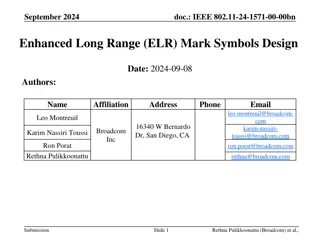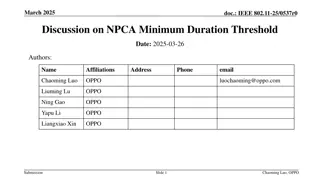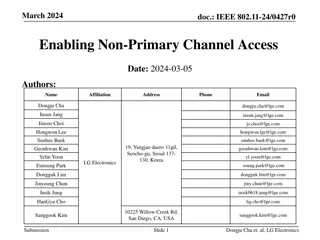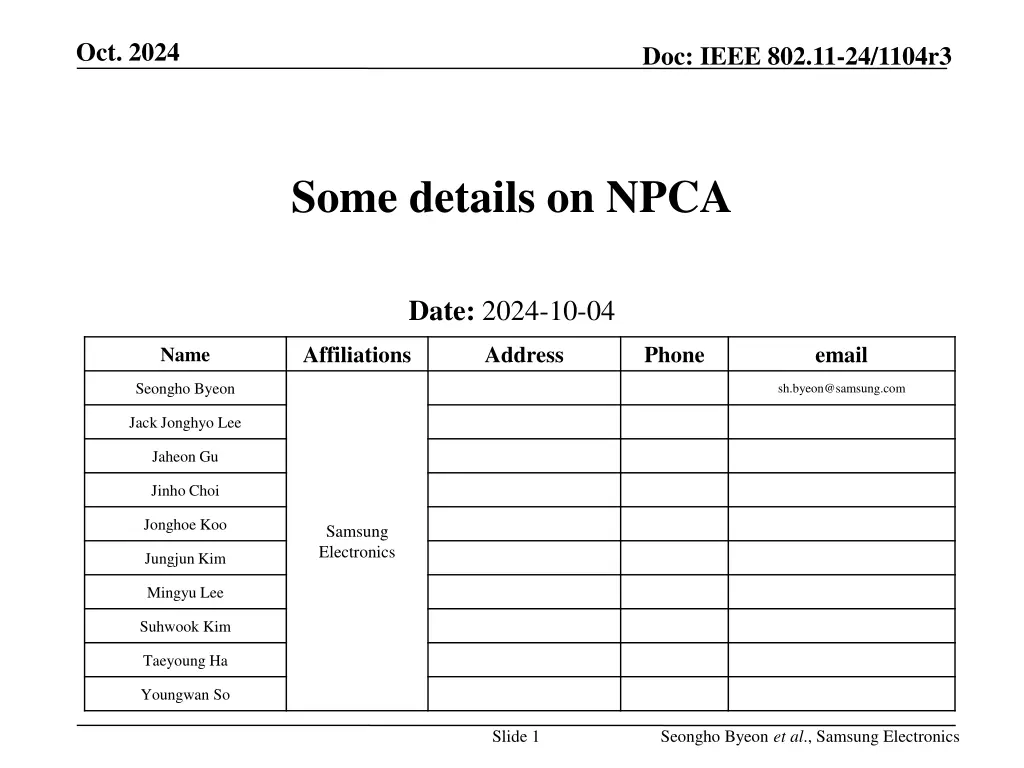
Details of Non-Primary Channel Access in IEEE 802.11-24/1104r3 Document
Explore the intricacies of Non-Primary Channel Access (NPCA) in the IEEE 802.11-24/1104r3 document, highlighting how STAs access secondary channels under specific conditions and the management of medium synchronization. Learn about NPCA duration, switching mechanisms, and coordination between AP and non-AP STAs.
Download Presentation

Please find below an Image/Link to download the presentation.
The content on the website is provided AS IS for your information and personal use only. It may not be sold, licensed, or shared on other websites without obtaining consent from the author. If you encounter any issues during the download, it is possible that the publisher has removed the file from their server.
You are allowed to download the files provided on this website for personal or commercial use, subject to the condition that they are used lawfully. All files are the property of their respective owners.
The content on the website is provided AS IS for your information and personal use only. It may not be sold, licensed, or shared on other websites without obtaining consent from the author.
E N D
Presentation Transcript
Oct. 2024 Doc: IEEE 802.11-24/1104r3 Some details on NPCA Date: 2024-10-04 Affiliations Address Phone email Name Seongho Byeon sh.byeon@samsung.com Jack Jonghyo Lee Jaheon Gu Jinho Choi Jonghoe Koo Samsung Electronics Jungjun Kim Mingyu Lee Suhwook Kim Taeyoung Ha Youngwan So Slide 1 Seongho Byeon et al., Samsung Electronics
Oct. 2024 Doc: IEEE 802.11-24/1104r3 Introduction One of main objectives for UHR PAR At least one mode of operation capable of improving efficient use of the medium Non-Primary Channel Access (NPCA) agreed in TGbn [1-7] TGbn defines a mode of operation that enables a STA to access the secondary channel while the primary channel is known to be busy due to OBSS traffic or other TBD conditions. The mode of operation shall not assume that the STA is capable to detect or decode a frame and obtain NAV information of the secondary channel concurrently with the primary channel. A BSS shall only have a single NPCA primary channel (name TBD) on which the STA contends while the primary channel of the BSS is known to be busy due to OBSS traffic or other TBD conditions. Slide 2 Seongho Byeon et al., Samsung Electronics
Oct. 2024 Doc: IEEE 802.11-24/1104r3 Introduction Some details on NPCA under discussion: When an OBSS TXOP and/or a PPDU transmission is detected on the primary channel in the BSS, NPCA-capable STAs will switch to the 20 MHz anchor channel within the secondary channel (i.e., non-primary channel, NPCH), not overlapping with the OBSS transmission Whether a non-AP STA can switch to the NPCH outside of its operating bandwidth How does NPCA AP STA or non-AP STA initiate its TXOP How to synchronize different OBSS views between NPCA AP STA and NPCA non-AP STAs How to manage medium synchronization, especially what should be done to protect existing transmissions in NPCH NPCA AP and non-AP STAs switch back to the primary channel before the expiration of BasicNAV or the end of OBSS PPDU transmission How to manage different switching delay capabilities when NPCA AP and non-AP STAs switch back to the primary channel In this contribution, we provide details on the above aspect further: Standardized criteria for determining when and for how long NPCA STAs switch to NPCH Improved coordination how the NPCA AP and non-AP STAs are synchronized Slide 3 Seongho Byeon et al., Samsung Electronics
Oct. 2024 Doc: IEEE 802.11-24/1104r3 When to switch Introducing the concept of NPCADuration NPCADuration: Time duration that NPCA AP and NPCA STAs perform NPCA Along with defining the following conditions, this provides opportunities to solve a variety of problems It is less than the primary channel s BasicNAV set by the OBSS or the duration of OBSS PPDU NPCA is terminated autonomously when it expires NPCADuration maybe different for each NPCA AP or NPCA STA, but their return timing to the primary channel after the expiration of NPCADuration is set equally for all In consideration of the separate capabilities of NPCA switching (back) delay Multiple TXOPs can be operated in NPCH within NPCADuration TXOP within NPCADuration is initiated by a control frame or the ICF/ICR exchange (e.g., RTS/CTS exchange) between STA and AP NPCA S80 R T S C T S B A B A B A OBSS PPDU OBSS PPDU P80 BasicNAV BasicNAV fixed CCA NPCDuration NPCDuration NPCDuration NPCDuration Switcing delay Example: Start NPCA after receiving the CTS of OBSS Slide 4 Seongho Byeon et al., Samsung Electronics
Oct. 2024 Doc: IEEE 802.11-24/1104r3 When to switch Introducing the concept of NPCADuration Specific conditions for setting NPCADuration 1. Receive PPDU preamble first, and get the information of the PPDU OBSS HE/EHT/UHR PPDU detection allows to get TXOP or PPDU duration w/ bandwidth [6] OBSS PPDU duration should be longer than a threshold (T1) Possible to secure NPCADuration as much as the transmission time of OBSS PPDU or the duration of OBSS TXOP minus switching delay, when the anchor channel is not overlapped If a pre-HE preamble including non-HT is received, without ongoing NAV settings, the entire PPDU may be received to obtain MPDU(s) Method to determine whether to run NPCA through pre-HE PPDU needs further discussion (TBD) 2. Detect OBSS TXOP through ICF/ICR exchange OBSS ICF-ICR exchange (e.g., non-HT format RTS/CTS) detection allows NPCA AP and NPCA STAs to set BasicNAV and get the OBSS bandwidth OBSS TXOP should be longer than a threshold (T2) Possible to secure NPCADuration as much as BasicNAV minus switching delay, when the anchor channel is not overlapped Slide 5 Seongho Byeon et al., Samsung Electronics
Oct. 2024 Doc: IEEE 802.11-24/1104r3 When to switch Duration of NPCA operation Preamble detection OBSS *[NOTE] Performing NPCA after receiving a Legacy PPDU (i.e., pre-HE PPDU) is TBD HE/EHT/UHR PPDU* PPDU duration or TXOP is larger than ?? ICF/ICR Reception exchange confirmed Wait for the next preamble detection Bandwidth does not overlap with the anchor channel BasicNAV set and is larger than ?? Bandwidth does not overlap with the anchor channel Run NPCADuration Slide 6 Seongho Byeon et al., Samsung Electronics
Oct. 2024 Doc: IEEE 802.11-24/1104r3 How to Coordinate TXOP operation within NPCADuration AP has to check which STAs are running NPCA, to schedule PPDUs STAs running NPCA also need to verify whether AP is performing NPCA Then, AP and STAs performing NPCA can initiate multiple TXOPs within NPCADuration After the start of NPCA, we may need to establish a coordinated rule regarding who and how initiates the TXOP Slide 7 Seongho Byeon et al., Samsung Electronics
Oct. 2024 Doc: IEEE 802.11-24/1104r3 How to Coordinate Difficulties in coordination Problem 1. Information imbalance and asymmetry Different NPCA switching delay capabilities among STAs Especially, the STAs switching to NPCH outside of its operating bandwidth experience significant delays Different view on the OBSS that triggered NPCA (i.e., OBSS hidden from each other) May have heterogeneous NPCA duration and available NPCA Hidden node problem b/w NPCA AP, NPCA STA, and OBSS STAs Problem 2. Medium synch management Obligation required to provide a protection for the existing transmissions in NPCH Similarity with medium access recovery procedure for EMLSR Considering the general operation scenario of NPCA, MediumSyncDelay Timer could be too long Might be harsh for each STA to send RTS only up to dot11MSDTXOPMax trial The threshold for determining idleness should be set more conservative way To simultaneously identify STAs performing NPCA, short MU-based control frame is required Problem 3. Collisions in the anchor channel Immediately after the start of NPCA, simultaneous accesses by a large number of STAs could result in severe collisions Initialized EDCA parameters in NPCH can exacerbate the collision probability (e.g., if 10 STAs attempt initial access at the same time in the anchor channel, the probability of collision reaches almost 50%) [NOTE] Default value of dot11MSDTXOPMax is 1 Slide 8 Seongho Byeon et al., Samsung Electronics
Oct. 2024 Doc: IEEE 802.11-24/1104r3 How to Coordinate Proposal: After performing an NPCA, we can define a mode of operation that at least the first TXOP operates as a trigger-based TXOP (i.e., exclusively for AP access) [P1] The AP can easily identify STAs performing NPCA through ICF-ICR exchange [P1] The AP can share its NPCA information (e.g., OBSS info, NPCA duration, etc.) in the trigger frame (i.e., ICF) to facilitate coordination [P1] If a STA does not receive any ICF (e.g., trigger frame) from the AP for a certain period time, it needs to terminate NPCA operation [P2] If NPCA STA receives ICF and is ED-idle (lower than TBD dBm conservatively) on the anchor channel, it can secure medium synchronization (Same goes for the AP regarding ICR) [P3] Since only the AP accesses the anchor channel in NPCH, collisions can be eliminated Slide 9 Seongho Byeon et al., Samsung Electronics
Oct. 2024 Doc: IEEE 802.11-24/1104r3 Example Scenario ICF may include AP s NPCA information such as NPCA duration and OBSS info Trigger-based TXOPs NPCA AP runs EDCA contention on the anchor channel within NPCH DL MU PPDU ICF BA S80 NPCA AP (160 MHz) DL MU PPDU Trigger frame maybe BSRP/BQRP/Basic/MU-BAR trigger frame with CS Required field set to true OBSS OBSS ICF OBSS ICR BA P80 OBSS PPDU NPCA AP initially tries to access the primary channel, but it detects OBSS ICF-ICR exchange Returning back to the primary channel, NPCA AP joins the contention after BasicNAV expired BasicNAV CCA NPCA duration of AP S80 ICR BA NPCA STAs (80 MHz or 160 MHz) ICR can contain OBSS information and/or NPCH channel info (NPCA duration, RSS, etc.), helping for NPCA AP to schedule NPCA STAs OBSS OBSS ICF OBSS ICR BA OBSS PPDU P80 NPCA STAs may try to access the primary channel initially, but it detects OBSS ICF-ICR exchange NPCA is terminated in advance, because of switching latency back to the primary channel Early termination of NPCA because of longer switching delay BasicNAV CCA NCPA duration of 80 STA which has the operating bandwidth of 80 MHz NCPA duration of 80 STA which has the operating bandwidth of 160 MHz Slide 10 Seongho Byeon et al., Samsung Electronics
Oct. 2024 Doc: IEEE 802.11-24/1104r3 Summary NPCA duration settings Total time that NPCA AP and NPCA STAs perform NPCA We can easily define and describe NPCA features (e.g., how to synch up between NPCA STAs) Triggered by HE/EHT/UHR OBSS PPDU preamble and/or OBSS TXOP Pre-HE is TBD TXOP operating mode configured as a trigger-based TXOP A method to easily solve difficult problems such as: Information imbalance and asymmetry Medium synch management Collisions in the anchor channel Sharing the NPCA duration in ICF/ICR on NPCH facilitates the better coordination and synchronization between the AP and STAs performing NPCA - By adjusting the NPCA duration, the AP can easily control the behavior of STAs Slide 11 Seongho Byeon et al., Samsung Electronics
Oct. 2024 Doc: IEEE 802.11-24/1104r3 Conclusion In this presentation, we defined the concept of NPCA duration, providing a starting point to consistently and easily proceed and describe various NPCA features, e.g., NPCA STA synch-up by sharing NPCA duration Furthermore, during NPCA operation, we examine potential coordination issues and proposed a mode of operation using a trigger- based TXOP to address them Slide 12 Seongho Byeon et al., Samsung Electronics
Oct. 2024 Doc: IEEE 802.11-24/1104r3 References [1] 11-23/2005r1 Non-primary channel access (NPCA) (Minyoung Park, Intel) [2] 11-24/0070r2 Some details about non-primary channel access (Yunbo Li, Huawei) [3] 11-24/0426r0 EDCA for Non-Primary Channel Access (Dongju Cha, LGE) [4] 11-24/0427r0 Enabling Non-Primary Channel Access (Dongju Cha, LGE) [5] 11-24/0458r2 Considerations on Non-Primary Channel Access (Salvatore Talarico, Sony) [6] 11-24/0498r0 Non-Primary Channel Access (NPCA) Follow Up (Minyoung Park, Intel) [7] 11-24/0496r1 Secondary Channel Usage Follow Up (Liwen Chu, NXP) [8] 11-24/1125r0 Considerations on switching for NPCA (Dongju Cha, LGE) [9] 11-24/1155r0 Further discussions on NPCA (Shawn Kim, WILUS) [10] 11-24/1218r0 NPCA Next level discussions (Gaurang Naik, Qualcomm) Slide 13 Seongho Byeon et al., Samsung Electronics

